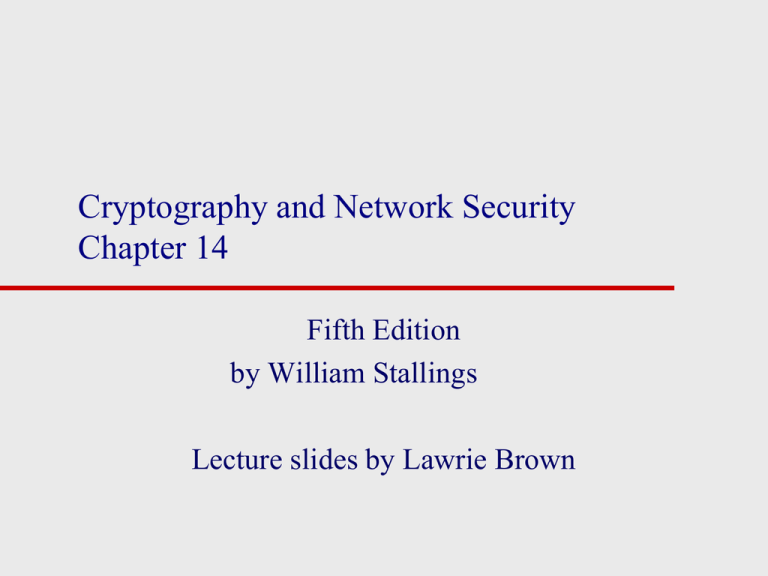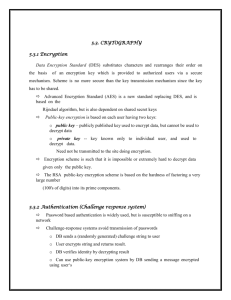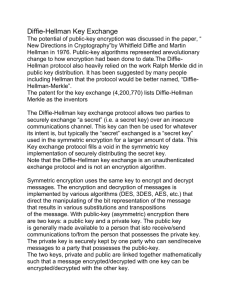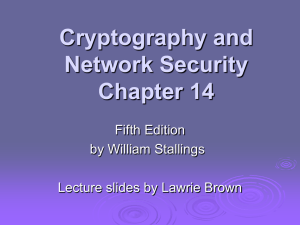Net331_chapter07 - Home - KSU Faculty Member websites
advertisement

Cryptography and Network Security
Chapter 14
Fifth Edition
by William Stallings
Lecture slides by Lawrie Brown
Key Distribution and Management
Symmetric key cryptography: fast implementations, good
for encrypting large amounts of data; requires shared
secret key
Asymmetric (public) key cryptography: inefficient for
large data, good for authentication; no need to share a
secret
How to share symmetric keys?
How to distribute public keys?
Symmetric Key Distribution using Symmetric Encryption
Objective: two entities share same secret key
Principle: change keys frequently
How to exchange a secret key?
1. A physically delivers key to B
2. Third party, C, can physically deliver key to A and B
3. If A and B already have a key, can securely transmit new key to
each other, encrypted with old key
4. If A and B have secure connection with third party C, C can securely
send keys to A and B
Symmetric Key Distribution using Symmetric Encryption
Option 1 and 2: manual delivery; feasible if number of entities is
small (link encryption)
Option 3: requires initial distribution of key; discovery of initial key
releases all subsequent keys.
Option 4: requires initial distribution of key with C; practical for
large-scale systems (end-to-end encryption)
Link Encryption vs End-to-End Encryption
Link Encryption
– Encrypt data over individual links in network
– Each link end-point shares a secret key
– Decrypt/Encrypt at each device in path
– Requires all links/devices to support encryption
End-to-End Encryption
– Encrypt data at network end-points (e.g. hosts or applications)
– Each pair of hosts/applications share a secret key
– Does not rely on intermediate network devices
How Many Keys Need To Be Exchanged?
Link-level encryption?
End-to-end encryption between hosts?
End-to-end encryption between applications?
Key Hierarchy
Key Distribution Centre (KDC) is trusted third party
typically have a hierarchy of keys
– Data sent between end-systems encrypted with
temporary session key
– Session keys obtained from KDC over network;
encrypted with master key
– Master keys can be distributed using manual delivery
The Use of a Key Hierarchy
Key Distribution Scenario
KDC Scenario Notation
End-systems: A and B, identified by IDA and IDB
Master keys: Ka, Kb
Session key (between A and B): Ks
Nonce values: N1, N2
E.g. timestamp, counter, random value
Must be different for each request
Must be difficult for attacker to guess
Key Distribution Issues
Hierarchical Key Control
– Use multiple KDCs in a hierarchy
– E.g. KDC for each LAN (or building); central KDC to exchange keys between
hosts in different LANs
– Reduces effort in key distribution; limits damage if local KDC is compromised
Session Key Lifetime
– Shorter lifetime is more secure; but increases overhead of exchanges
– Connection-oriented protocols (e.g. TCP): new session
– key for each connection
– Connection-less protocols (e.g. UDP/IP): change after fixed period or certain
number of packets sent
Decentralized Key Distribution
Alternative
that doesn't rely on KDC
I Each end-system must manually exchange n – 1
master keys (Km) with others
Symmetric Key Distribution using
Asymmetric Encryption
Asymmetric encryption generally too slow for encrypting large amount of
data
Common application of asymmetric encryption is exchanging secret keys
Three examples:
– 1. Simple Secret Key Distribution
– 2. Secret Key Distribution with Confidentiality and Authentication
– 3. Hybrid Scheme: Public-Key Distribution of KDC Master Keys
Simple Secret Key Distribution
Simple: no keys prior to or after communication
Provides confidentiality for session key
Subject to man-in-the-middle attack
Only useful if attacker cannot modify/insert messages
Public-Key Distribution of Secret
Keys
Provides both confidentiality and authentication in exchange of secret
key
Hybrid Scheme: Public-Key Distribution of KDC Master
Keys
Use public-key distribution of secret keys when exchanging master
keys between end-systems and KDC
Efficient method of delivering master keys (rather than manual
delivery)
Useful for large networks, widely distributed set of users with single
KDC
Distribution of Public Keys
By design, public keys are made public
Issue: how to ensure public key of A actually belongs to A (and not
someone pretending to be A)
Four approaches for distributing public keys
1.
Public announcement
2.
Publicly available directory
3.
Public-key authority
4.
Public-key certificates
Uncontrolled Public-Key Distribution
Make public key available in open forum: newspaper,email signature, website,
conference, . . .
Problem: anyone can announce a key pretending to be another user
Public Announcement
users
distribute public keys to recipients or
broadcast to community at large
– eg. append PGP keys to email messages or post
to news groups or email list
major weakness is forgery
– anyone can create a key claiming to be
someone else and broadcast it
– until forgery is discovered can masquerade as
claimed user
Public-Key Publication
All users publish keys in central directory
Users must provide identification when publishing key
Users can access directory electronically
Weakness: directory must be secure
Publicly Available Directory
can
obtain greater security by registering keys
with a public directory
directory must be trusted with properties:
– contains {name,public-key} entries
– participants register securely with directory
– participants can replace key at any time
– directory is periodically published
– directory can be accessed electronically
still vulnerable to tampering or forgery
Public-Key Authority
Improve security by tightening control over distribution of keys from
directory
Has properties of directory
Assume each user has already security published publickey at
authority; each user knows authorities public key
Does require real-time access to directory when keys are needed
Public-Key Authority
First 5 messages are for key exchange; last 2 are authentication of users
Although 7 messages, public keys obtained from authority can be cached
Problem: authority can be bottleneck
Alternative: public-key certificates
Public-Key Certificates
Assume public keys sent to CA can be authenticated by CA; each user
has certificate of CA
Public-Key Certificates
certificates
allow key exchange without real-time
access to public-key authority
a certificate binds identity to public key
– usually with other info such as period of
validity, rights of use etc
with all contents signed by a trusted Public-Key
or Certificate Authority (CA)
can be verified by anyone who knows the publickey authorities public-key
Public Key Certificates
A certificate is the ID and public-key of a user signed by CA
CA = E(PRauth; [T|| IDA || PUa])
Timestamp T validates currency of certificate (expiration date)
Common format for certificates is X.509 standard (by ITU)
– S/MIME (secure email)
– IP security (network layer security)
– SSL/TLS (transport layer security)
– SET (e-commerce)
X.509 Certificates
issued by a Certification Authority (CA), containing:
–
–
–
–
–
–
–
–
–
–
–
version (1, 2, or 3)
serial number (unique within CA) identifying certificate
signature algorithm identifier
issuer X.500 name (CA)
period of validity (from - to dates)
subject X.500 name (name of owner)
subject public-key info (algorithm, parameters, key)
issuer unique identifier (v2+)
subject unique identifier (v2+)
extension fields (v3)
signature (of hash of all fields in certificate)
notation CA<<A>> denotes certificate for A signed by CA
X.509 Certificates
Obtaining a Certificate
any
user with access to CA can get any certificate
from it
only the CA can modify a certificate
because cannot be forged, certificates can be
placed in a public directory






